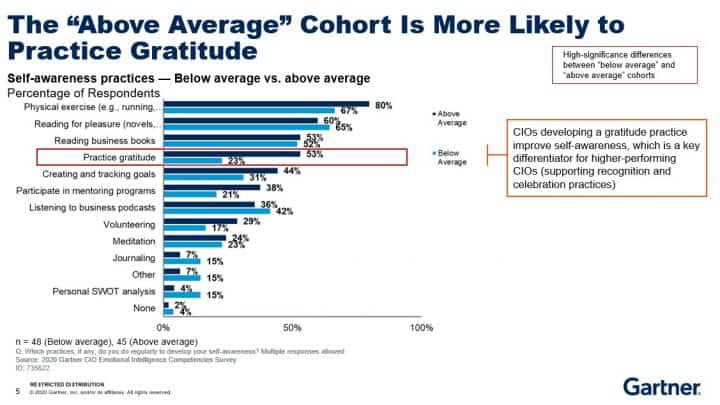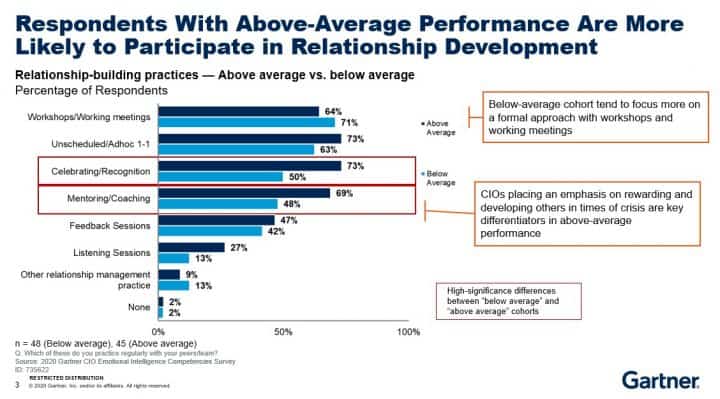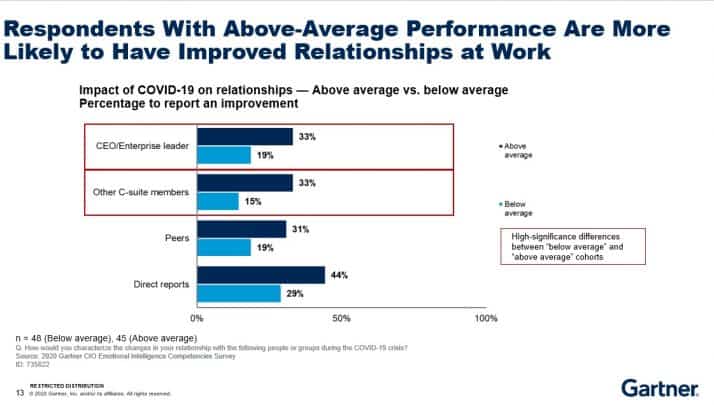Every CIO (and human for that matter) has at their disposal competencies that, when put into practice, can have a genuinely transformative effect. Transformative to those around them and to their own internal state.
What are these mythical powers I hear you ask? I’ll keep you in suspense a little longer. First though, here’s the evidence.
What are the ingredients of an “above average” CIO?
Findings from our CIO Emotional Competency survey (we ran it in late 2020) helped uncover exactly what practices and habits above-average performing CIOs displayed. This is compared to those that reported below-average performance.
The survey was comprised of questions closely aligned to the SIMPLER model research and framework. This focused on the key competencies leaders needed to thrive in and through a crisis. Ninety-three members of Gartner’s CIO research circle responded. The results were fascinating.
You can check out the full survey results that reveal all the powers we discovered here but let’s focus on two and a half. The second one has two parts hence the half!
Powerful Pratice#1 – Gratitude. Yes, Gratitude.
In the survey, we discovered that “above average” CIOs are 30% more likely to practice gratitude than those reporting below-average performance. This one simple yet underused practice can have a profound effect on leadership performance. Let’s look at the science to know more.
Figure 1 – Practice Gratitude – It’s Free

Why has it such power?
When practicing gratitude, defined as “the quality of being thankful; readiness to show appreciation for and to return kindness,” the brain releases oxytocin and serotonin. These “happy hormones” make us feel better.
In fact, gratitude is not only good for those that receive it, it’s good for those that give it too. Digging further, I found an abundance of research that backups up this claim. In one scientific research paper, it outlines the benefits in more detail covering:
- Psychological benefits: Leads to more positive emotions and thoughts. It can increase self-satisfaction, enhance mood and improve levels of optimism.
- Physical benefits: Strengthens the immune system, optimizes blood pressure and cardiac function and improves sleep-wake cycles.
- Social benefits: Better communication, more empathy, stronger interpersonal relationships, greater team involvement and likability. It increases social trust.
So, if you want to start feeling better and helping others feel more motivated, engagement, and feeling like they’re making a difference, start by practising gratitude. Do it often but make it genuine. Give specific thanks, sincerely. It’s not hard to do. It just requires discipline and action. But the ROI can be and is huge. If the thought of it makes you freeze up or uncomfortable, that’s ok. It’s not something that comes naturally to everyone. It gets easier with practice.
Practice#2 – Recognize and Develop Others.
Another key insight from the survey emerged from asking a question relating to relationship development practices. While both above and below-average performing CIOs responded very similarly to most of the practices identified, two specific approaches stood out (see figure 2 below). And it’s here that the above and below average were set apart.
Figure 2 – Build Relationships with Recognition and Developing Others

Celebrate and Recognise Others Often
CIOs that placed an emphasis on celebrations and recognition with their team were much more likely to be above-average and build greater relationships. As a result, this can lead to greater psychological wellbeing and trust. In challenging times, like we’re going through, employees crave recognition. It triggers the release of dopamine which can have a very positive effect on the ability to focus and motivation. What’s more, it’s at every CIOs disposal. For more tips on this practice, check out another blog post reigniting employee engagement here.
Servant Leadership through Coaching and Mentoring
In addition to recognition, above-average performing CIOs prioritized investing time and effort in the development of others through coaching and mentoring. Even with so much disruption happening around them during the pandemic, taking time to help develop their direct reports and team members across the organization was more of a priority for the above-average CIOs.
This servant leadership approach is a trait that is becoming more and more essential in contemporary leadership styles. And again, while not always a natural or default position, it’s one that can be nurtured with deliberate practice.
The Simple Practices Pay Off.
While these practices were not the only standout differences between the above and below average respondents, they do stand out as ones that show a marked difference between the two cohorts.
When questioned about overall relationships at work since the pandemic began, the above-average cohort was seen to have a marked improvement in their relationships upward (CEO), laterally (across the C-suite and with peers) and with their direct reports compared to those below average (see figure 3).
Figure 3 – Impact of COVID19 on relationships for CIOs

The pandemic related disruption is set to continue. Even more worrisome, disruptions are expected to increase in the future. CIOs must look to prioritize time on their calendars to unleash the underutilized superpowers they have within them. It may feel a little alien or uncomfortable at first. Persevere. It will make a difference.
Thanks for taking the time to read this.
Stay safe and well.
First published on Gartner Blog Network





